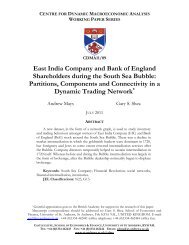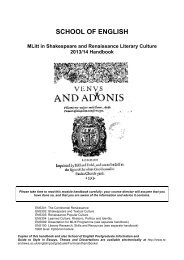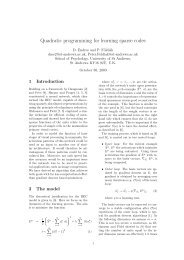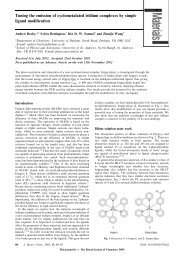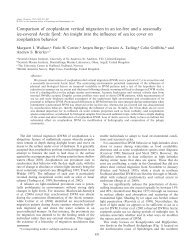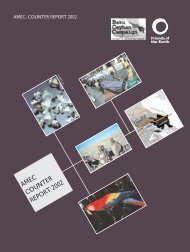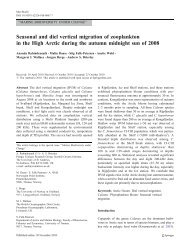introduction what is social anthropology? - University of St Andrews
introduction what is social anthropology? - University of St Andrews
introduction what is social anthropology? - University of St Andrews
You also want an ePaper? Increase the reach of your titles
YUMPU automatically turns print PDFs into web optimized ePapers that Google loves.
d<strong>is</strong>agree and write contradictory things, and that all printed matter <strong>is</strong> not ind<strong>is</strong>putable just because<br />
it lies between hard covers. Note that as well as showing evidence <strong>of</strong> reading <strong>of</strong> set texts, good<br />
answers link the essay topic back to material given in lectures or tutorials. You can also gain marks<br />
by including additional reading, providing it <strong>is</strong> clear from your essay that you have actually read it!<br />
5. Don't then sit down and write the essay or report. Plan it first. Give it a beginning, a middle, and<br />
an ending. Much <strong>of</strong> the information you will have collected will have to be rejected because it <strong>is</strong>n't<br />
relevant. Don't be tempted to include anything that hasn't a direct bearing on the problem<br />
expressed in the title <strong>of</strong> the essay or report. Note that in the introductory paragraph it <strong>is</strong> a good<br />
idea to make it absolutely clear to the reader exactly <strong>what</strong> you understand by certain crucial<br />
concepts you will be d<strong>is</strong>cussing in the essay ‐these concepts will probably be those which appear in<br />
the essay title. Define these concepts if you think there may be any ambiguity about them. Note<br />
also that when you give examples to illustrate a point be careful not to lose track <strong>of</strong> the argument.<br />
Examples are intended to illustrate a general (usually more abstract) point; they are not a<br />
substitute for making th<strong>is</strong> point.<br />
6. When you finally start on the essay or report, please remember these points:<br />
(a) Leave wide margins and a space at the end for comments. Any work that <strong>is</strong> illegible, obviously<br />
too long or too short, or lacking margins and a space at the end will be returned for re‐writing.<br />
Essays should be typed, preferably on one side <strong>of</strong> the paper and double‐spaced.<br />
(b) Append a bibliography giving details <strong>of</strong> the material you have read and cited in the essay.<br />
Arrange it alphabetically by author and by dates <strong>of</strong> publication. Look at the Journal <strong>of</strong> the Royal<br />
Anthropological Institute as an example <strong>of</strong> the style <strong>of</strong> presenting a bibliography.<br />
N.B. In the body <strong>of</strong> the essay or report, whenever you have occasion to support a statement by<br />
reference to a book or article, give in brackets the name <strong>of</strong> the author and date. To acknowledge a<br />
quotation or a particular observation, the exact page number should be added. For example,<br />
'Shortly after the publication <strong>of</strong> The Andaman Islanders, Radcliffe‐Brown drew attention to the<br />
importance <strong>of</strong> the mother's brother (Radcliffe‐Brown 1924). What kindled h<strong>is</strong> interest in the South<br />
Africanmaterial was the pseudo‐h<strong>is</strong>torical interpretation <strong>of</strong> Henri Junod (Radcliffe‐Brown 1952:<br />
15) ...........' If you are not sure how to do th<strong>is</strong>, look in the journal Journal <strong>of</strong> the Royal<br />
Anthropological Institute or some monograph in the library to get an idea <strong>of</strong> how th<strong>is</strong> <strong>is</strong> done.<br />
Alternatively, footnote your references. Note that if you simply copy a writer's words into your<br />
essay without acknowledgement you will lose marks, and could even receive a zero mark.<br />
7. Footnotes should be placed either at the foot <strong>of</strong> each page, or all together at the end. If on each<br />
page, they should be numbered consecutively from the beginning <strong>of</strong> each chapter, e.g. 1‐22. If<br />
placed all together at the end, they should be numbered consecutively throughout the whole<br />
research project, e.g. 1‐103, in which case do not start renumbering for each chapter.<br />
8. Footnote references in the text should be clearly designated by means <strong>of</strong> superior figures, placed<br />
after punctuation, e.g. ................the exhibition. 10<br />
9. Underlining (or italics) should include titles <strong>of</strong> books and periodical publications, and technical<br />
terms or phrases not in the language <strong>of</strong> the essay, (e.g. urigubu, gimwali).<br />
10. Italicize: ibid., idem., op.cit., loc.cit., and passim.<br />
11. Single inverted commas should be placed at the beginning and end <strong>of</strong> quotations, with double<br />
inverted commas for quotes‐within‐quotes.<br />
12. If quotations are longer than six typed lines they should be indented, in which case inverted<br />
commas are not needed.<br />
36




